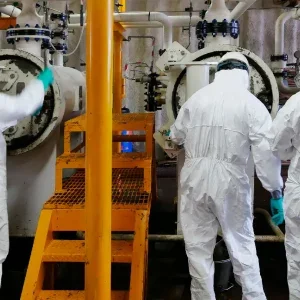
To be located in the Maasvlakte Energy Hub, Port of Rotterdam, the proposed H2Maasvlakte project is in the final stages of a front-end engineering and design (FEED) study, with FID scheduled for 2024. Assuming a positive FID, Plug will supply 100 MW of electrolysis capacity, consisting of ten prefabricated PEM (proton exchange membrane) electrolyser arrays, to produce green hydrogen by 2026/early 2027, rapidly expanding that capacity to 500 MW by 2030 “at the latest”, says Uniper. The project will employ Plug’s mature stack electrolyser technology. The hydrogen produced would be used for feedstock in the chemical industry and refineries as well as for low-carbon mobility.
The H2Maasvlakte FEED study is being performed by Uniper, together with Technip Energies and Plug Power. The FEED study is supported by Topsector Energie (TSE) subsidies of the Dutch Ministry of Economic Affairs and Climate.
Support from the EU Innovation Fund makes a “significant contribution” to the realisation of the project, says Uniper. The fund received 239 applications, from which 41 were selected, including H2Maasvlakte. The latter was favoured because of “Uniper’s commitment to transforming existing fossil production sites into green energy sites.”
The Rotterdam harbour area, which includes the Maasvlakte, is the largest carbon-emitting industrial cluster in the Netherlands, Uniper notes. In 2021 the area emitted 23.4 Mton of carbon dioxide and “decarbonising this area alone would contribute significantly to the Dutch overall target to reach net zero by 2050.”
“As a port authority we support, stimulate and help companies in Rotterdam to reach the Paris climate treaty goals in multiple ways, including getting infrastructure like a hydrogen pipeline network in place in time”, said Allard Castelein, CEO of Port of Rotterdam.
“The H2Maasvlakte project marks a significant milestone for Europe’s transition to more sustainable, localised energy in response to geopolitical risk and climate change,” said Andy Marsh, CEO of Plug.
The Port of Rotterdam (PoR) presents significant opportunities for green hydrogen projects, notes Uniper, with the presence of multiple potential off-takers across the planned open access regional hydrogen backbone representing a huge demand for green hydrogen.
The Maasvlakte Energy Hub is “versatile and strategically located”, says Uniper and “all the necessities for a successful energy transition come together here”, with power from offshore wind farms, a port suitable for the import of green fuels,
and “pivotal infrastructure” such as the high-voltage grid and the future hydrogen pipeline network (being built by Hynetwork Services, a subsidiary of GasUnie, working with PoR).
The MPP3 power plant, one of the key production units of Uniper’s Maasvlakte Energy Hub, has an installed capacity of 1070 MW and runs on coal, biomass and residual (waste byproduct) flows from surrounding industry. As well as electricity, it supplies steam to local industrial consumers.
The Maasvlakte Energy Hub also includes various gas-fired production facilities and a large hybrid battery. In the coming years, Uniper plans to develop applications for green hydrogen and bio-fuels at the hub, among other things.
Green hydrogen “will facilitate the energy transition for the petrochemical, mobility, power and heating industries”, Uniper believes and notes that in the Netherlands, the momentum behind hydrogen is growing.
Uniper says its Maasvlakte site “is one of the most convenient locations to realise a large scale green H2 project” and offers “multiple synergies” including:
- Sufficient land available for large-scale green hydrogen production.
- Ability to make use of existing infrastructure: grid connections; demineralised water; natural gas network (could initially be used to blend H2); and cooling water systems of existing power generation assets.
- Opportunities to recycle waste heat from H2 production.
- Availability of power from offshore wind, with 3.5 – 5.5 GW landing at neighbouring TenneT substation within this decade.
- Proximity to Rotterdam hydrogen network (Port of Rotterdam & Gasunie), less than 3 km away as from 2023. This will be integrated, in the longer term, with the national hydrogen backbone towards neighbouring Germany.
- Nearby hydrogen consumers (chemical industry) currently using grey hydrogen that will need to decarbonise to achieve EU targets.
- Ability to benefit from the major role the Port of Rotterdam is likely to play from around 2030 onwards in the import of hydrogen, for Rotterdam and the surrounding area as well as neighbouring countries.
This article first appeared in Modern Power Systems magazine.






